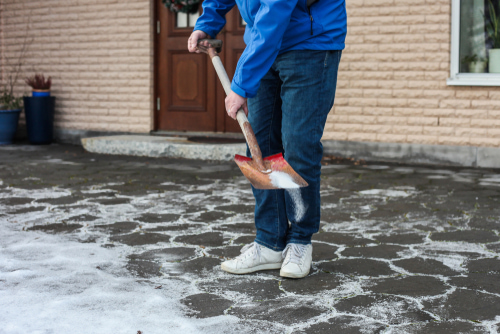
Winter weather can quickly form ice on front steps, pavements, and entryways. A thin layer of ice is all it takes to cause an accident and make snow removal more difficult. On top of that, the traditional rock salt method of keeping surfaces free of ice comes with its own disadvantages. It can crack concrete, harm plants and soil, and even cling to footwear and damage interiors if it gets brought in.
The good news is that liquid de-icer snow removal in Decatur can prevent ice from forming in the first place, without all the drawbacks of dry salt. But to make the most out of this method, it’s important to ensure proper timing. So, when is the right time to apply salt brine? Let’s find out!
Is pre-salting worth it?
Absolutely. Pre-salting, which is also known as anti-icing, involves applying salt brine to surfaces before a storm begins. Instead of removing ice after it forms, this method is a preventive measure that stops ice from forming on pavements, entryways, and other surfaces in the first place.
Because of its high efficiency and cost-effectiveness, this method is becoming increasingly popular today among homeowners and contractors. Some of the most important benefits of pre-salting include:
- Making snow and ice removal easier, saving time and effort.
- Prevents damage to concrete, plants, and surfaces.
- Helps keep pedestrians and vehicles safe from accidents.
- Reduces the amount of salt necessary for effective de-icing.
When to apply salt brine?
In a nutshell, salt brine is best applied as a proactive treatment. Timely application is crucial to ensure lasting results and avoid some of the common de-icing mistakes. Here’s how to time your application to be most effective:

- 12–24 hours before a snowstorm is ideal, when the pavement is still dry
- Shortly before freezing rain begins, so the brine has time to bond to the surface
- Avoid applying during active precipitation, as heavy rain or snow can wash it away
If you’re uncertain, feel free to consult with professionals. Reputable de-icing experts monitor weather conditions to ensure proper timing, greatly reducing the risk of ineffective treatment.
At what temperature is salt brine effective?
When it comes to proper application, another important thing to consider is temperature. Understanding limits is essential for effective treatment while minimizing waste and surface damage.
To be more specific, brine works best at temperatures above 20°F. This is the ideal condition to apply it, and the solution can efficiently prevent ice crystals from bonding to the surfaces, preventing slipping hazards and making snow removal easier. Below 20°F, the melting power of standard brine starts to decline, and ice may still form.
To address very low temperatures, professionals often use additional techniques and special formulas to enhance the salt brine effect. These additives will lower the freezing point of the solution, making it effective even when the temperature drops further.
Who provides high-quality liquid de-icer snow removal in Decatur, IL?

As a family-run business with a tradition of excellence, Classy Grass is the #1 choice for a variety of lawn care and snow removal services, including proactive anti-icing treatment. Our experienced team comes equipped with high-grade tools, attention to detail, and customer-tailored solutions, ensuring that treatment is done according to the highest standards.
Whether you live close to Richland Community College or anywhere else in Decatur, you can count on our team to deliver anti-icing right on time, so that you can move freely when temperatures plummet. Reach out today!